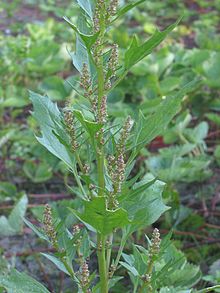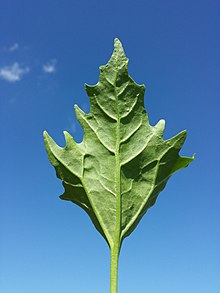Red goosefoot
| Red goosefoot | ||||||||||||
|---|---|---|---|---|---|---|---|---|---|---|---|---|

Red goosefoot ( Oxybasis rubra ) |
||||||||||||
| Systematics | ||||||||||||
|
||||||||||||
| Scientific name | ||||||||||||
| Oxy base rubra | ||||||||||||
| ( L. ) S. Fuentes , Uotila & Borsch |
The red goose foot ( Oxybasis rubra , syn .: Chenopodium rubrum ), also called red goose foot , is a plant species in the family of the foxtail plants (Amaranthaceae). It is native to Central Europe and spread across the entire northern hemisphere.
description
Vegetative characteristics
The red goose foot is an annual herbaceous plant with heights of growth of usually 10 to 80 (up to 150) cm. The upright or prostrate-ascending, mostly strongly branched stem is light green or purple-red, indistinctly striped, ribbed and bare.
The alternate leaves are divided into leaf blades and petioles. The green or reddish leaves are somewhat fleshy, not aromatic, and (almost) the same color on both sides. The petiole has a length of 0.5 to 4.5 mm. The leaf blade is triangular, ovate or rhombic-ovate with a length of 1 to 9 cm and a width of 1 to 6 cm. The leaf base narrows into a wedge shape into the petiole. The leaf margin is irregularly deeply dentate, with three to five pairs of triangular, slightly inwardly curved teeth. The uppermost leaves can sometimes have almost entire margins.
Inflorescence and flower
The lateral, branched peep-eared inflorescences contain almost spherical, ball-shaped partial inflorescences with a diameter of 2 to 5 mm. The prophylls are linear with a length of 0.4 to 2 cm.
The flowers are hermaphroditic or feminine. The green, often red fruit to time perianth is at the terminal flowers in the tangle of four to five tepals , at the side of three flowers usually only in the lower part fused tepals. The Tepalenzipfel are obovate-lanceolate to elliptical, up to 1 mm long and up to 0.8 mm wide, mostly glabrous, rounded on the back (occasionally keeled). There are two to three stamens present. On the ovary are two very short scars.
Fruit and seeds
At the time of fruiting, the fruit is surrounded by the green, often red-turning flower envelope. The fruit is egg-shaped, the membranous, white, reticulate-dotted pericarp does not lie against the seed. The vertical, oblique or horizontal seed measures 0.6 to 1 (1.2) mm in diameter, is spherical or broadly flat-ovoid with a round outline and a blunt edge. The reddish-brown to red-black seed coat is smooth or covered with very small, elongated pits.
Chromosome number
The number of chromosomes is 2n = 36, an investigation also found 2n = 18.
ecology
The red goosefoot is a food plant for the caterpillars of the yellow leaf tensioner ( Pelurga comitata ).
Flower ecology
The flowering period extends from July to September. The pollination is often carried by the wind or by selfing, rarely by insects.
Occurrence and endangerment
The red goosefoot is widespread across the northern hemisphere (circumpolar) in Europe , the temperate regions of Asia and North America . As an introduced species, it is also found in other areas.
In Central Europe, the red goose foot inhabits nitrogen-rich river reporting corridors, for example on gravel banks, which in the system of plant sociology are named after him Chenopodietum rubri . It also grows in short-lived ruderal corridors ( Sisymbrion ) on fresh to moist soils, for example on village streets, open sewers, dung sites or rubble sites. It rises from the plain to mid-mountain ranges. Occasionally it also occurs in salt plant corridors or in lime and nutrient-rich loam u. Clay fields ahead.
The red goose foot is considered a pointer plant for excessive nitrogen abundance in the soil .
The species native to Germany is not endangered nationwide. In Saarland and Baden-Württemberg , however, it is considered endangered ( Red List of Endangered Species 3).
In Switzerland too , the red goose foot is considered endangered or threatened with extinction in some regions.
Systematics
Oxybasis rubra (L.) S. Fuentes, Uotila & Borsch belongs to the tribe Atripliceae in the subfamily Chenopodioideae within the family Amaranthaceae .
It was first published as Chenopodium rubrum in 1753 by Carl von Linné in Species Plantarum . Molecular genetic studies revealed that the species does not belong to Chenopodium in the narrower sense. Therefore, it was placed in the genus Oxybasis by Suzy Fuentes-Bazan , Pertti Uotila and Thomas Borsch in 2012 .
Synonyms for Oxybasis rubra (L.) S. Fuentes, Uotila & Borsch , which are based on the same type specimen, are Blitum rubrum (L.) Rchb. , Chenopodium rubrum L. , Orthosporum rubrum (L.) T. Nees , Atriplex rubra (L.) Crantz , Blitum polymorphum var. Rubrum (L.) Beck , Botrys rubra (L.) Lunell and Orthospermum rubrum (L.) Opiz .
Other synonyms are Blitum acuminatum Schur , Blitum maritimum Nutt. , Blitum polymorphum C.A.Mey. , Blitum polymorphum var. Humile (Hook.) Moq. , Blitum rubrum C.A.Mey. , Blitum rubrum var. Crassicaule Boq. , Blitum rubrum var. Humile (Hook.) Moq. , Blitum rubrum var. Hypoleucum Speg. , Blitum rubrum var. Macrospermum (Hook.f.) Speg. , Botrys humilis (S. Watson) Lunell , Chenopodium acuminatum Schur (nom. Illeg.), Chenopodium astracanium Ledeb. , Chenopodium blitoides Lej. , Chenopodium humile Hook. , Chenopodium macrospermum Moq. (nom. illeg.), Chenopodium matthioli Bertol. ex Moq. , Chenopodium patulum Mérat , Chenopodium pygmaeum Menyh. , Orthospermum acuminatum Schur and Orthospermum crassifolium Schur .
use
The leaves of the red goosefoot can be cooked raw or cooked like spinach. Raw leaves should because of their content of saponins are, however, consumed only in small quantities. The seeds can be ground as a flour additive. It is recommended that you soak them overnight and then rinse them thoroughly to remove the saponins.
The whole plant can be used as a coloring plant for golden-green shades.
Common names
The other common German-language names for the red goose foot also existed or existed : Blutkraut, Gänsefuß, Mehlnele ( Lucerne , Bern , Schwyz ), Mistmölten ( Silesia ), Neunspitzen, Saubalg (Silesia), Sautod (Silesia) and Schweintod (Silesia).
supporting documents
- Henning Haeupler, Thomas Muer: picture atlas of the fern and flowering plants of Germany . Ed .: Federal Agency for Nature Conservation (= The fern and flowering plants of Germany . Volume 2 ). Eugen Ulmer, Stuttgart (Hohenheim) 2000, ISBN 3-8001-3364-4 , pp. 89 . (Sections Description, Occurrence)
- Steven E. Clemants, Sergei L. Mosyakin: Chenopodium . In: Flora of North America Editorial Committee (Ed.): Flora of North America North of Mexico . Volume 4: Magnoliophyta: Caryophyllidae, part 1 . Oxford University Press, New York / Oxford a. a. 2003, ISBN 0-19-517389-9 , Chenopodium rubrum , p. 282 (English, online ). (Sections Description, Occurrence)
- Gelin Zhu, Sergei L. Mosyakin, Steven E. Clemants: Chenopodium . In: Wu Zhengyi, Peter H. Raven, Deyuan Hong (Eds.): Flora of China . Volume 5: Ulmaceae through Basellaceae . Science Press / Missouri Botanical Garden Press, Beijing / St. Louis 2003, ISBN 1-930723-27-X , Chenopodium rubrum , p. 379 (English, online ). (Sections Description, Occurrence)
Individual evidence
- ↑ a b c d Susy Fuentes-Bazan, Pertti Uotila, Thomas Borsch: A novel phylogeny-based generic classification for Chenopodium sensu lato, and a tribal rearrangement of Chenopodioideae (Chenopodiaceae) . In: Willdenowia. Volume 42, No. 1, 2012, pp. 5–24 (here: p. 15), DOI: 10.3372 / wi.42.42101 .
- ↑ Entry in Botanik im Bild / Flora von Österreich, Liechtenstein and Südtirol
- ↑ a b Chenopodium rubrum at Tropicos.org. Missouri Botanical Garden, St. Louis, accessed January 31, 2012.
- ↑ Gaden S. Robinson, Phillip R. Ackery, Ian J. Kitching, George W. Beccaloni, Luis M. Hernández: Entry at HOSTS - A Database of the World's Lepidopteran Hostplants , accessed on January 31, 2012.
- ↑ Chenopodium rubrum at Biolflor.de
- ^ Oxybasis rubra in the Germplasm Resources Information Network (GRIN), USDA , ARS , National Genetic Resources Program. National Germplasm Resources Laboratory, Beltsville, Maryland. Retrieved July 4, 2013.
- ↑ Erich Oberdorfer : Plant-sociological excursion flora . With the collaboration of Theo Müller. 5th, revised and expanded edition. Eugen Ulmer, Stuttgart (Hohenheim) 1983, ISBN 3-8001-3429-2 , pp. 345 .
- ↑ a b c Red goosefoot. In: FloraWeb.de.
- ↑ Entry in Info Flora , accessed January 31, 2012
- ↑ Carl von Linné: Species Plantarum. Volume 1, Lars Salvius, Stockholm 1753, p. 218 ( digitized version ).
- ^ Entry in The Plant List , accessed January 31, 2012.
- ↑ a b Chenopodium rubrum at Plants For A Future . Retrieved January 31, 2012.
- ^ Georg August Pritzel , Carl Jessen : The German folk names of plants. New contribution to the German linguistic treasure. Philipp Cohen, Hannover 1882, p. 92 ( online ).
Web links
- Red goosefoot. In: FloraWeb.de.
- Distribution map for Germany. In: Floraweb .
- Chenopodium rubrum L. In: Info Flora , the national data and information center for Swiss flora .
- Distribution in the northern hemisphere from: Eric Hultén, Magnus Fries: Atlas of North European vascular plants. 1986, ISBN 3-87429-263-0 at Den virtuella floran (swed.)
- Thomas Meyer: Data sheet with identification key and photos at Flora-de: Flora von Deutschland (old name of the website: Flowers in Swabia )
- Distribution map for Europe
- Günther Blaich: Photos of European plants. Chenopodium rubrum.





